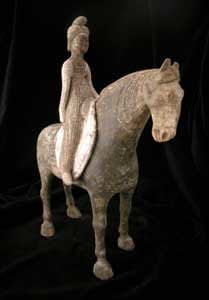Tang Horse with Removable Saddle and Female Rider, 618 CE - 906 CE
Painted Terracotta
height 40 cm
height 15 3/4 in
height 15 3/4 in
H.1015
Further images
During the Tang Dynasty, horses were revered, considered relatives of the mythical dragon. This veneration was well earned, for the speed and stamina of these majestic animals ensured the protection...
During the Tang Dynasty, horses were revered, considered relatives of the mythical dragon. This veneration was well earned, for the speed and stamina of these majestic animals ensured the protection of the northern borders against barbarian invaders as well as enhancing communication capabilities between far away provinces, thereby aiding in the expansion of the empire. The need to import horses from Central Asia influenced the creation of the Silk Road. Thus, they were also prized for their rarity. Naturally then, horses became a status symbol for the aristocratic elite. Polo and other equestrian pastimes became popular. This sculpture, depicting a lady-in-waiting riding on the back of a gray horse with its head held downwards, reveals this connection between nobility and the horse. Perhaps the most remarkable feature of this work is the removable saddle and rider that detach from the body of the horse in one piece. Some of the original polychrome still remains intact, clearly visible in the lady’s burgundy dress and the white numnah, or saddle blanket. We can imagine this lady prancing around on this horse, perhaps taking part in an important ceremony. She wears a long-sleeved dress, a type of which was used in a popular dance where the lady swirls the excess fabric around in the air. Discovered buried inside a tomb, this work was supposed to accompany the deceased throughout the afterlife. The striking beauty of this work is even more impressive, considering that it was created specifically for interment and was not supposed to be seen by the living. Today, we marvel in the beauty of this sculpture as much as its tremendous history and intriguing legacy.









